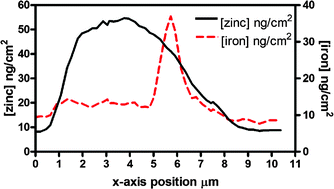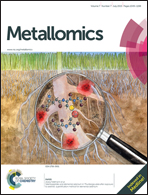Understanding metal homeostasis in primary cultured neurons. Studies using single neuron subcellular and quantitative metallomics†
Abstract
The purpose of this study was to demonstrate how single cell quantitative and subcellular metallomics inform us about both the spatial distribution and cellular mechanisms of metal buffering and homeostasis in primary cultured neurons from embryonic rat brain, which are often used as models of human disease involving metal dyshomeostasis. The present studies utilized synchrotron radiation X-ray fluorescence (SRXRF) and focused primarily on zinc and iron, two abundant metals in neurons that have been implicated in the pathogenesis of neurodegenerative diseases such as Alzheimer's disease and Parkinson's disease. Total single cell contents for calcium, iron, zinc, copper, manganese, and nickel were determined. Resting steady state zinc showed a diffuse distribution in both soma and processes, best defined by the mass profile of the neuron with an enrichment in the nucleus compared with the cytoplasm. Zinc buffering and homeostasis was studied using two modes of cellular zinc loading – transporter and ionophore (pyrithione) mediated. Single neuron zinc contents were shown to statistically significantly increase by either loading method – ionophore: 160 million to 7 billion; transporter 160 million to 280 million atoms per neuronal soma. The newly acquired and buffered zinc still showed a diffuse distribution. Soma and processes have about equal abilities to take up zinc via transporter mediated pathways. Copper levels are distributed diffusely as well, but are relatively higher in the processes relative to zinc levels. Prior studies have observed iron puncta in certain cell types, but others have not. In the present study, iron puncta were characterized in several primary neuronal types. The results show that iron puncta could be found in all neuronal types studied and can account for up to 50% of the total steady state content of iron in neuronal soma. Although other metals can be present in iron puncta, they are predominantly iron containing and do not appear to be associated with ferritin cages or transferrin receptor endosomes. The iron content and its distribution in puncta were similar in all neuron types studied including primary dopaminergic neurons. In summary, quantitative measurements of steady state metal levels in single primary cultured neurons made possible by SRXRF analyses provide unique information on the relative levels of each metal in neuronal soma and processes, subcellular location of zinc loads, and have confirmed and extended the characterization of heretofore poorly understood cytoplasmic iron puncta.

- This article is part of the themed collection: Alzheimer's Research Month 2016

 Please wait while we load your content...
Please wait while we load your content...